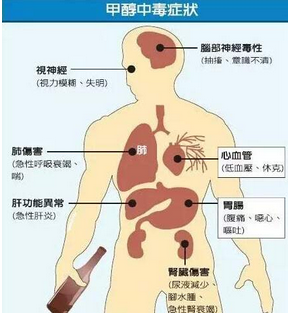Methanol Poisoning: Causes, Symptoms, Essential Steps
Once in the body, methanol converts into chemicals like formic acid, which can damage organs, cause blindness, or even be fatal. Quick action is critical. Recognizing the signs early and seeking immediate medical care can save lives. This guide explains the causes of methanol poisoning, what symptoms to watch for, and the steps you should take to protect yourself or others.
What is Methanol?
Methanol, also known as wood alcohol, is a colorless, volatile liquid with a slight odor. While methanol is common in many households, it’s not safe for human consumption.For an in-depth look at ethanol’s uses and risks, refer to Methanol Overview on Methanol.org.
Mechanism of Poisoning
Once methanol enters the bloodstream, it’s metabolized by enzymes in the liver into formaldehyde and later into formic acid. This metabolic process is where the real danger begins. Formic acid is highly toxic and disrupts cellular function, leading to organ failure. Unlike ethanol (drinking alcohol), which the body can process safely, methanol’s byproducts accumulate and cause severe damage, especially to the optic nerve and central nervous system. More details about methanol metabolism can be found on Methanol Toxicity – NCBI.

Symptoms of Methanol Poisoning
Identifying methanol poisoning symptoms early is crucial. They often appear in two stages:
Early Symptoms:
- Nausea and vomiting: These are among the first signs of methanol ingestion.
- Abdominal pain: This may indicate irritation caused by toxicity.
- Headaches and dizziness: Methanol’s effect on the nervous system can cause these symptoms.
- Blurred vision: As the optic nerve is affected, visual disturbances often emerge.
Late Symptoms:
- Severe visual impairment or blindness: Prolonged exposure to methanol metabolites can cause irreversible damage to the eyes.
- Seizures: These occur due to methanol’s toxicity in the nervous system.
- Difficulty breathing: Formic acid buildup can lead to acidosis, causing respiratory distress.
- Coma: In extreme cases, methanol poisoning lads to coma and potentially death
If any of these symptoms arise following exposure to methanol, it’s imperative to seek immediate medical help. A comprehensive guide to methanol poisoning symptoms can be found at MedlinePlus.
Understanding the nature of methanol poisoning and its warning signs can save lives. This knowledge is the first step to ensuring safety when dealing with this hazardous substance.
Treatment Options for Methanol Poisoning
When methanol poisoning occurs, quick and effective treatment is essential to prevent severe complications such as blindness or death. This section will explain the two primary types of treatment: antidotes to counteract methanol’s toxicity and supportive care provided in hospital settings.
Antidotes: Fomepizole and Ethanol
Antidotes play a critical role in stopping the toxic chain reaction caused by methanol.
- Fomepizole: This is the first-line choice due to its high specificity and fewer side effects. By blocking ADH, fomepizole prevents the formation of toxic metabolites. According to studies, fomepizole significantly lowers the risk of complications from methanol poisoning. For detailed clinical insights, refer to the NEJM article on fomepizole.
- Ethanol: While not as specific as fomepizole, ethanol is a widely available alternative. It competes with methanol for binding to ADH, reducing the enzyme’s capacity to break methanol down into harmful byproducts. More details oethanol treatment are available here.
Both antidotes are most effective when administered early, ideally before significant symptoms or organ damage occur
Supportive Care in Hospital
The specific treatments depend on the severity of poisoning and other individual factors.
- Airway Management: Patients may require intubation if they experience respiratory distress or are unconscious. Ensuring clear and functioning airways is crucial.
- Correction of Acidosis: Methanol poisoning often leads to metabolic acidosis, a condition where the blood becomes too acidic
- Hemodialysis: In severe cases, hemodialysis is employed to rapidly remove methanol and its toxic byproducts from the bloodstream. This method is particularly effective in preventing further damage to organs. Learn more about hemodialysis for methanol poisoning via Methanol.org.
- Electrolyte Management: Electrolyte levels, including potassium and calcium, may be monitored and corrected as necessary. This ensures optimal heart and nerve function during recovery.
For a comprehensive understanding of hospital management for methanol poisoning, you can explore the MSF treatment protocol.
When faced with methanol poisoning, prompt and effective intervention through antidotes and hospital care can make the difference between life and tragic outcomes.
Conclusion
Methanol poisoning is a critical emergency requiring immediate recognition and action.Early symptoms like nausea, blurred vision, and dizziness signal danger, while delayed treatment risks severe outcomes like blindness or death.
Treatments like fomepizole, ethanol, and supportive care, including hemodialysis, are effective but time-sensitive. Awareness and preparedness can save lives.
Share this information to help others recognize and address methanol poisoning. Prompt treatment makes all the difference.






